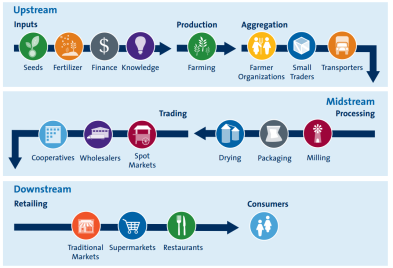By Alice Marks, @alicemarks0

Credit, FAO
On April 26th 2016 The Chicago Council on Global Affairs released their new report, Growing Food for Growing Cities: Transforming food systems in an urbanizing world, as part of their Global Food Security Symposium in Washington, DC. According to UN figures, two-thirds of the global population is expected to live in urban areas by 2050, and this report looks at how such rapid urbanisation is changing the structure and functionality of the entire global food system, from the source of inputs to the farm and on to the consumer.
With urbanisation and the accompanying expansion of urban middle classes comes a shift in dietary expectations and demands. Traditional staple diets such as cereals, roots and pulses are increasingly supplemented with a wide variety of higher-value foods such as fresh fruit and vegetables, or meat and dairy products. For example, in some African countries including Uganda and Tanzania up to 66% of urban household food expenditure is on foods other than staple grains.
Value chains have potential

Chicago Council, 2016
According to the report, if agricultural and supply chains are to accommodate the growing demands of the cities, they will need to “lengthen geographically, increasing the potential to reach farmers in more and more distant areas.” No longer is ‘farm to fork’ a simple process that serves local populations; increasingly it is a complex and far-reaching chain, involving many actors that might cross borders and even continents.
This could provide opportunities for smallholder farmers and rural people to engage in value chains in order to meet the demands and diversify their incomes to improve resilience to shocks. However, many rural people in developing countries encounter barriers to their engagement, such as insufficient transport links to get produce to markets, or a lack of access to credit in order to purchase inputs and expand capacity beyond growing only staples, to include crops for the urban markets. There are also a number of gaps or bottlenecks in the off-farm activities of the new and more complex value chains, where under the right circumstances entrepreneurs could engage and employment could be created.
Benefits and risks of changing diets

Processing soy drinks at SESACO food processing factory, Kampala, Uganda
The changing food systems have the potential to increase the diversity of diets and make them more nutritious, but the report highlights that there is also the risk that that excessive consumption of highly processed food may cause “health problems like obesity, diabetes, hypertension, and other diet-related diseases”. These effects are beginning to show in developing countries already, where in the last 30 years the number of overweight or obese adults increased from 250 million in 1980 to almost one billion by 2008. This alarming trend follows in the footsteps of developed nations where diet-related diseases are already widespread. These risks make it all the more important to ensure that processing and adding value to foods can be achieved in such a way as to avoid these risks and that fresh, nutritious foods reach urban markets. Indeed, according to Bert Garza, speaking at the Chicago Council Symposium on Tuesday, “the reason we have an agricultural sector is not just to keep people from being hungry, but to help them to be healthy”
The popularity of processed foods, in particular, is on the rise. The report suggests that this is partially for convenience, as women increasingly move into the workforce they have not only a growing income but also more pressure on their time, which means food that is faster to prepare is more desirable, or that “priority is being placed on better time utilization”. While processed foods may be less time-intensive for the consumer, they are more labour-intensive to produce, which creates an opportunity to add value before it reaches the plate. In addition, the modern urban market is less seasonal and demands higher-value crops year-round, so farmers will have the incentive to grow higher-value crops in multiple seasons, but only if they can actually access these markets.
“Investment that is smart and deliberate”
In Africa alone, the agriculture and food sector is expected to reach $1 trillion by 2030, offering potentially attractive opportunities for investment by the private sector. Indeed, the scale of the investment needed in order to provide enough food for the cities, particularly in developing countries, is likely to necessitate private investment in order to ensure the food supply is secure.
However, the public sector, national and local governments will also have an important role to play, especially in ensuring that the most vulnerable or marginalised rural people are not left behind. This is particularly pertinent for women, who typically have less access to inputs and markets than their male counterparts, and youth, who often struggle to find employment – in Africa over 70% of youth live on less than $2 per day. This is because the opportunities that can be offered by developing value chains may not necessarily or inherently include smallholders. Therefore, it will be important that intelligent and deliberate policies are made that promote the interests of vulnerable groups, including creating an environment where investment that supports sustainable rural development is welcome.









Leave a comment